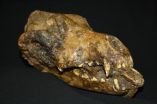(Press-News.org) A new analysis of European archaeological sites containing large numbers of dead mammoths and dwellings built with mammoth bones has led Penn State Professor Emerita Pat Shipman to formulate a new interpretation of how these sites were formed. She suggests that their abrupt appearance may have been due to early modern humans working with the earliest domestic dogs to kill the now-extinct mammoth -- a now-extinct animal distantly related to the modern-day elephant. Shipman's analysis also provides a way to test the predictions of her new hypothesis. Advance publication of her article "How do you kill 86 mammoths?" is available online through Quaternary International.
Spectacular archaeological sites yielding stone tools and extraordinary numbers of dead mammoths -- some containing the remains of hundreds of individuals -- suddenly became common in central and eastern Eurasia between about 45,000 and 15,000 years ago, although mammoths previously had been hunted by humans and their extinct relatives and ancestors for at least a million years. Some of these mysterious sites have huts built of mammoth bones in complex, geometric patterns as well as piles of butchered mammoth bones.
"One of the greatest puzzles about these sites is how such large numbers of mammoths could have been killed with the weapons available during that time," Shipman said. Many earlier studies of the age distribution of the mammoths at these sites found similarities with modern elephants killed by hunting or natural disasters, but Shipman's new analysis of the earlier studies found that they lacked the statistical evaluations necessary for concluding with any certainty how these animals were killed.
Surprisingly, Shipman said, she found that "few of the mortality patterns from these mammoth deaths matched either those from natural deaths among modern elephants killed by droughts or by culling operations with modern weapons that kill entire family herds of modern elephants at once." This discovery suggested to Shipman that a successful new technique for killing such large animals had been developed and its repeated use over time could explain the mysterious, massive collections of mammoth bones in Europe.
The key to Shipman's new hypothesis is recent work by a team led by Mietje Germonpré of the Royal Belgian Institute of Natural Sciences, which has uncovered evidence that some of the large carnivores at these sites were early domesticated dogs, not wolves as generally had been assumed. Then, with this evidence as a clue, Shipman used information about how humans hunt with dogs to formulate a series of testable predictions about these mammoth sites.
"Dogs help hunters find prey faster and more often, and dogs also can surround a large animal and hold it in place by growling and charging while hunters move in. Both of these effects would increase hunting success," Shipman said. "Furthermore, large dogs like those identified by Germonpré either can help carry the prey home or, by guarding the carcass from other carnivores, can make it possible for the hunters to camp at the kill sites." Shipman said that these predictions already have been confirmed by other analyses. In addition, she said, "if hunters working with dogs catch more prey, have a higher intake of protein and fat, and have a lower expenditure of energy, their reproductive rate is likely to rise."
Another unusual feature of these large mammoth kill sites is the presence of extraordinary numbers of other predators, particularly wolves and foxes. "Both dogs and wolves are very alert to the presence of other related carnivores -- the canids -- and they defend their territories and food fiercely," Shipman explained. "If humans were working and living with domesticated dogs or even semi-domesticated wolves at these archaeological sites, we would expect to find the new focus on killing the wild wolves that we see there."
Two other types of studies have yielded data that support Shipman's hypothesis. Hervé Bocherens and Dorothée Drucker of the University of Tubingen in Germany, carried out an isotopic analysis of the ones of wolves and purported dogs from the Czech site of Predmostí. They found that the individuals identified as dogs had different diets from those identified as wolves, possibly indicating feeding by humans. Also, analysis of mitochondrial DNA by Olaf Thalmann of the University of Turku in Finland, and others, showed that the individuals identified as dogs have a distinctive genetic signature that is not known from any other canid. "Since mitochondrial DNA is carried only by females, this finding may indicate that these odd canids did not give rise to modern domesticated dogs and were simply a peculiar, extinct group of wolves," Shipman said. "Alternatively, it may indicate that early humans did domesticate wolves into dogs or a doglike group, but the female canids interbred with wild wolf males and so the distinctive female mitochondrial DNA lineage was lost."
As more information is gathered on fossil canids dated to between 45,000 and 15,000 years ago, Shipman's hunting-dog hypothesis will be supported "if more of these distinctive doglike canids are found at large, long-term sites with unusually high numbers of dead mammoths and wolves; if the canids are consistently large, strong individuals; and if their diets differ from those of wolves," Shipman said. "Dogs may indeed be man's best friend."
INFORMATION:
[ P. L. S. / B. K. K. ]
CONTACTS
Pat Shipman: pat.shipman9@gmail.com, 919-542-5539
Barbara K. Kennedy (PIO): science@psu.edu, 814-863-4682
IMAGES
High-resolution images are online at http://science.psu.edu/news-and-events/Shipman5-2014
Domestication of dogs may explain mammoth kill sites and success of early modern humans
2014-05-29
ELSE PRESS RELEASES FROM THIS DATE:
NASA widens 2014 hurricane research mission
2014-05-29
VIDEO:
During this year's Atlantic hurricane season, NASA is redoubling its efforts to probe the inner workings of hurricanes and tropical storms with two unmanned Global Hawk aircraft flying over storms...
Click here for more information.
During this year's Atlantic hurricane season, NASA is redoubling its efforts to probe the inner workings of hurricanes and tropical storms with two unmanned Global Hawk aircraft flying over storms and two new space-based missions.
NASA's ...
Mechanisms of ibrutinib resistance identified in chronic lymphocytic leukemia
2014-05-29
COLUMBUS, Ohio – A new study has discovered how resistance develops in patients taking ibrutinib, a new and highly effective drug for the treatment of chronic lymphocytic leukemia (CLL).
The study was published in the New England Journal of Medicine and led by researchers at The Ohio State University Comprehensive Cancer Center – Arthur G. James Cancer Hospital and Richard J. Solove Research Institute (OSUCCC – James). It identifies gene mutations that cause ibrutinib resistance in CLL patients.
"Knowledge of these mutations is the first step in the development of ...
New tools help protect world's threatened species
2014-05-29
Athens, Ga. – New tools to collect and share information could help stem the loss of the world's threatened species, according to a paper published today in the journal Science. The study—by an international team of scientists that included John L. Gittleman, dean of the University of Georgia Odum School of Ecology—was led by Stuart L. Pimm of Duke University and Clinton N. Jenkins of the Instituto de Pesquisas Ecológicas in Brazil.
"As databases coalesce and policymakers have access to greater information, we see real and improving successes for conservation science," ...
Two GOES-R instruments complete spacecraft integration
2014-05-29
VIDEO:
In addition to monitoring weather on Earth, the GOES-R satellites will monitor weather in space caused by electromagnetic radiation and charged particles released from solar storms on the Sun. Many...
Click here for more information.
Two of the six instruments that will fly on NOAA's first Geostationary Operational Environmental Satellite - R (GOES-R) satellite have completed integration with the spacecraft. The Solar Ultraviolet Imager (SUVI) and Extreme Ultraviolet and ...
New report details more geoscience job opportunities than students
2014-05-29
Alexandria, Va. – In the American Geosciences Institute's newest Status of the Geoscience Workforce Report, released May 2014, jobs requiring training in the geosciences continue to be lucrative and in-demand. Even with increased enrollment and graduation from geoscience programs, the data still project a shortage of around 135,000 geoscientists needed in the workforce by the end of the decade.
"Industry has recognized, and is mitigating the upcoming shortage of skilled geoscientists in their employ, but the federal geoscience workforce is still demonstrably shrinking" ...
Study: Baltimore hookah bars contain elevated levels of carbon dioxide and air nicotine
2014-05-29
Smoking waterpipes, or hookahs, creates hazardous concentrations of indoor air pollution and poses increased risk from diminished air quality for both employees and patrons of waterpipe bars, according to a new study from the Institute for Global Tobacco Control at the Johns Hopkins Bloomberg School of Public Health. In an analysis of air quality in seven Baltimore waterpipe bars, researchers found that airborne particulate matter and carbon monoxide exceeded concentrations previously measured in public places that allowed cigarette smoking and that air nicotine was markedly ...
PCOS diagnosis tied to inflammation during pregnancy
2014-05-29
Washington, DC—Women who have polycystic ovary syndrome – the most common hormone disorder in women of reproductive age – are more likely to experience chronic low-grade inflammation during pregnancy than counterparts who do not have the condition, according to a new study published in the Endocrine Society's Journal of Clinical Endocrinology & Metabolism (JCEM).
Polycystic ovary syndrome, or PCOS, is a leading cause of infertility. Symptoms can include irregular or absent menstrual periods, infertility, weight gain, acne, excess hair on the face and body, or thinning ...
Study finds mode of transportation affects how we feel
2014-05-29
What mode of transportation makes you happiest?
Clemson researchers investigated how emotions like happiness, pain, stress, sadness and fatigue vary during travel and by travel mode in a new study published in the journal Transportation.
Utilizing data from the American Time Use Survey, collected by the Bureau of Labor Statistics, the researchers were able to determine the average mood felt by people during different types of travel.
"We found that people are in the best mood while they are bicycling compared to any other mode of transportation," said Eric Morris, ...
Study: New genes identified may unlock mystery of keloid development
2014-05-29
DETROIT – Researchers at Henry Ford Hospital in Detroit have uncovered previously unidentified genes that may be responsible for keloid scarring, a discovery that could unlock the mystery of keloid development and provide insight for more effective treatment.
"Much of the uncertainty surrounding keloids is rooted in there being no known cause for their development," says study lead author Lamont R. Jones, M.D., vice chair, Department of Otolaryngology-Head and Neck Surgery at Henry Ford.
"But it is believed that keloids have a genetic component given the correlation ...
How breast cancer 'expresses itself'
2014-05-29
About one in eight women in the United States will contract breast cancer in her lifetime. Now new research from Tel Aviv University-affiliated researchers, in collaboration with Johns Hopkins University, has provided another tool to help women, clinicians, and scientists searching for a cure to the one of the most widespread yet incurable diseases on the planet.
Dr. Ella Evron and Dr. Ayelet Avraham of the TAU-affiliated Assaf Harofeh Medical Center, together with Prof. Saraswati Sukumar of Johns Hopkins, have found that "gene regulation," the process that shuts off ...




